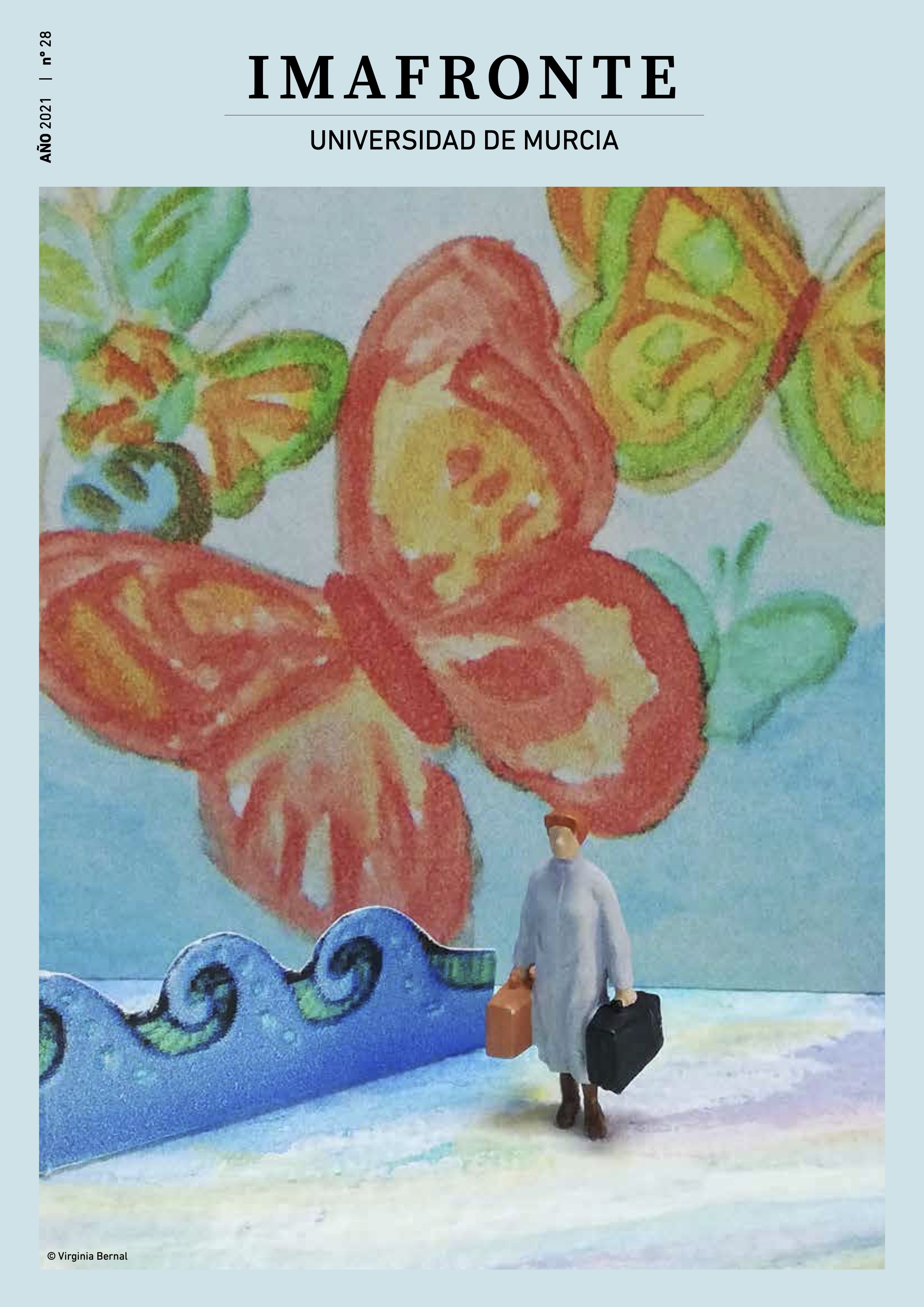The construcction of the american archetype. The cinematographic and television image of Abraham Lincoln in the Unites States
Abstract
The historical legacy of Abraham Lincoln has made him probably the most important U.S. president. His support of the Union, the abolition of slavery and the Civil War have made him the central figure of contemporary American understanding. That is why Lincoln has been a landmark in American film history. From early filming to the present day, the 16th President has been a representational archetype of the historical periods in which his figure has been reconstructed. A figure mainly linked to periods of crisis in which his mediating character and political intelligence were endorsed as models of American affirmation. Lincoln, who had been able to unite and reconcile the nation in the most critical period of its young chronology, became the model for the construction of the American myth. His mention shed light on the dark periods of depression and the Second World War. When his country became the world’s hegemonic power, his figure was transmuted into visual memory as a reference in the face of abuses of power and manipulative policies.
Downloads
-
Abstract1605
-
PDF (Español (España))701
-
EPUB (Español (España))95
References
Álvarez Junco, J. (2017). Dioses útiles. Naciones y nacionalismos. Barcelona: Galaxia Gutenberg.
Benbow, M. E. (2010). Birth of a Quotation: Woodrow Wilson and “Like Writing History with Lightning. The Journal of the Giled Age and Progressive Era, 9 (4) pp. 509-533. https://www.jstor.org/stable/20799409 [Consultado el 1 de mayo de 2021].
Caparrós Lera, J. M. (2009). La guerra civil americana vista por el cine. Palabra clave Vol. 12, número 2, diciembre de 2009: pp. 195-206. https://palabraclave.unisabana.edu.co/index.php/palabraclave/article/view/1560 [Consultado el 11 de mayo de 2021].
Casas, Q., Losilla C. y Eisenstein, S. M. (2017). El joven Lincoln, Barcelona: La Aventura.
De Francisco, A. y Blackburn, R. (2013). Guerra y emancipación. Lincoln & Marx. Madrid: Capitán Swing.
De la Guardia Herrero, C. (2008). Abraham Lincoln y la Unión de los Estados Unidos. En Flores Juberías C. (ed), Todos los hombres del presidente. La presidencia de los Estados Unidos vista a través del cine. Valencia: Quaderns del MuVim, 27-41.
Díaz-Cuesta, J. (2013). El hombre y su representación en Lincoln (Steven Spielberg, 2012): un análisis textual. Historia y Comunicación Social, (18) Nº Esp, 653-666. https://doi.org/10.5209/rev_HICS.2013.v18.44356 [Consultado el 19 de abril de 2021].
Fletcher, G. P. (2001). Our secret Constitution. How Lincoln Redefined American Democracy. Nueva York: Oxford University Press.
Gallagher, T. (2009). John Ford. El hombre y su cine. Barcelona: Akal.
Gimferrer, P. (2000). Cine y literatura. Barcelona: Seix Barral.
Goyeneche-Gómez, E. (2012). Las relaciones entre cine, cultura e historia: una perspectiva de investigación audiovisual. Palabra clave 15 (3), 387-414. https://www.redalyc.org/articulo.oa?id=64924872003 [Consultado el 27 de abril de 2021].
Gutiérrez Delgado, R. (2011) Young Mr. Lincoln (1939): El rastro de la historia en un mito de John Ford. Filmhistoria Online, 2 (21) http://revistes.ub.edu/index.php/filmhistoria/article/view/13838 [Consultado el 26 de abril de 2021].
Gutiérrez Delgado, R. (2011). Abe Lincoln, pasión y justicia en la ficción fordiana. Young Mr. Lincoln (1939): un perfil épico. En G. Camarero (Ed.), La biografía fílmica: actas del Segundo Congreso Internacional de Historia y Cine, (pp. 810-830) Madrid: T&B. https://e-archivo.uc3m.es/handle/10016/11376 [Consultado el 26 de abril de 2021].
Kearns Goodwin, Doris. (2009). Team of Rivals. The Political Genius of Abraham Lincoln. Penguin: Nueva York.
Kushner, T. (2011). Lincoln. Final Shooting Script, https://stephenfollows.com/resource-docs/scripts/Lincoln-Screenplay.pdf [Consultado el 8 de mayo de 2021].
Lincoln, A. (2015). Por la libertad. Barcelona: Plataforma.
Lincoln, A. (1998). Discurso del 4 de marzo de 1861 en AA.VV. Discursos inaugurales. León: Universidad de León, 57-77.
Lincoln, A. (2005). El Discurso de Gettysburg y otros escritos sobre la Unión. Madrid: Tecnos.
Mariani, S. (2018). Salvar la Unión y abolir la esclavitud: Abraham Lincoln en su hora más gloriosa en M. Alcántara, S. Mariani, (Eds.), La política es de cine. Madrid: (CEPC) Ministerio de la Presidencia. (pp. 181-198) https://www.academia.edu/35910953/Salvar_la_Unión_y_abolir_la_esclavitud_Abraham_Lincoln_en_su_hora_más_gloriosa [Consultado el 21 de abril de 2021].
Marzal, J. J. (1998). David Wark Griffith. Cátedra: Madrid.
McBridge, J. (2004). Tras la pista de John Ford. T&B: Madrid.
Montero, I. (2004). Abraham Lincoln. Barcelona: Folio.
Morettin, E. (2011)., O cinema e o mito da democracia americana: Abraham Lincoln e John Ford. Famecos: midia, cultura e tecnología, 18, (1) pp. 11-22. https://doi.org/10.15448/1980-3729.2011.1.8794 [Consultado el 22 de abril de 2021].
Reinhard, M. S., (2009). Abraham Lincoln on Screen: Fictional and Documentary Portrayals on Film and Television. McFarland: Jefferson/Londres.
Rosenstone, Robert A., (1997). El pasado en imágenes. El desafío del cine a nuestra idea de la Historia. Ariel: Barcelona.
O´ Reilly, B. y Dugard, M. () Matar a Lincoln. Madrid: La esfera de los libros. Edición Kindle. www.amazon.com.
Paquet-Deyris, A. M. (2016). Form “Plain Abe” to Mythical Mr. Lincoln. Constructing varius representational modes of a screen icon, IdeAs [Online], 7 https://doi.org/10.4000/ideas.1424 [Consultado el 20 de abril de 2021].
Reinhard, M. S. (2009). Abraham Lincoln on Screen: Fictional and Documentary Portrayals on Film and Television. McFarland: Jefferson/Londres.
Sánchez-Escalonilla, A. Rodríguez Mateos, A., (2014). La recuperación fílmica de la figura presidencial norteamericana en un contexto de crisis: Hollywood durante los mandatos de Barack Obama (2009-2014) Fotocinema, 8, 255-283.
https://doi.org/10.24310/Fotocinema.2014.v0i8.5953 [Consultado el 29 de abril de 2021].
Scott, I. (2011). American Politics in Hollywood Film. Edimburgo: Edinburgh University Press.
Snee, B. J. (2016). Lincoln before Lincoln: Early Cinematic Adaptations of the Life of America's Greatest President. University Press of Kentucky: Lexinton.
Stokes, M. (2007). D. W. Griffith´s The Birth of a Nation. A History of “The Most Controversial Picture of All Time. Oxford: Nueva York. https://www.academia.edu/18422918/_Melvyn_Stokes_D_W._Griffith_s_The_Birth_of_a_Nat_Book_Fi_org_ [Consultado el 15 de abril de 2021].
Stokes, M. (2011). Abraham Lincoln and the Movies. American Ninetheeth Century History, 12, (2) pp. 203-231.
Vidal, G. (2013). Lincoln. Barcelona: Edhasa.
Vidal, G. (2007). Ensayos (1952-2001). Barcelona: Edhasa.
Copyright (c) 2021 Juan Agustín Mancebo Roca

This work is licensed under a Creative Commons Attribution-ShareAlike 4.0 International License.
1. The authors non-exclusively assign the exploitation rights (reproduction, distribution, communication and transformation) to the magazine.
2. The works published in this magazine are subject to the Attribution-ShareAlike 4.0 International license (CC By SA 4.0). Therefore, they can be copied, used, disseminated, transmitted and publicly displayed, provided that:
i) the authorship and the original source of its publication (journal, editorial and URL of the work) are cited, thus allowing its recognition.
ii) it is allowed to remix, transform or create from the material while maintaining the same license as the original.

3. Self-archiving conditions. Authors are allowed and encouraged to electronically disseminate the pre-print (version before being evaluated) and/or post-print (version evaluated and accepted for publication) versions of their works before publication, as it favors their publication. Earlier circulation and diffusion and with it a possible increase in its citation and reach among the academic community. Color RoMEO: verde.






















